Do you have a question about the Haier SUPER MATCH AS35S2SF2FA-CL and is the answer not in the manual?
Explains the model name structure and its components.
Safety warnings and cautions specifically for repair work.
Safety precautions to be taken after the product has been repaired.
Checks to be performed after the repair is completed.
Explains the use and meaning of icons in the manual.
Wiring diagram for the indoor unit of the air conditioner.
Overview of the main operational modes and control logic.
Details on how the cooling mode operates, including temperature control and fan speed.
Explanation of the dehumidifying operational mode and its parameters.
Details on heating mode operation, including temperature compensation.
Describes the 'strength' operation mode.
Explains the 'mute' operation mode for quiet performance.
Mentions air refreshing feature but notes it's not applicable to this model.
Details on setting 24-hour on/off timing for the system.
Explains the dormant operation mode and its temperature adjustments.
Describes the functionality of the urgency button for quick control.
Explains the low load protection mechanism to prevent frosting.
Details the high load protection to prevent overheating.
Describes how abnormal indoor system operations are handled and reported.
Explains how the malfunction list is presented and restored.
Methods to confirm various abnormalities like sensor failures.
How to operate a single indoor unit independently.
Explains how the system status is saved during power interruptions.
Details the procedure for running a system test program.
Explains a function related to timing and CPU speed.
Describes the functionality and usage of room cards.
Warnings and conditions for initiating a diagnostic procedure.
Lists common problems, check items, and measures for diagnosis.
Lists error codes and their descriptions for indoor display.
Details abnormalities related to thermistors and troubleshooting steps.
Explains EEPROM errors and their causes/solutions.
Describes indoor fan motor faults and how to check them.
Details faults related to the outdoor DC fan motor and troubleshooting.
Explains IPM protection issues and their resolutions.
Describes compressor over-current faults and troubleshooting.
Details communication faults between IPM and outdoor PCB.
Explains power supply over/under voltage faults and diagnosis.
Describes overheat protection for discharge temperature.
Details communication faults between indoor and outdoor units.
Explains loss of synchronism detection for the inverter side.
Describes high work-intense protection in heating mode.
Step-by-step guide to removing the front panel of the indoor unit.
Instructions for lifting and removing the control box cover.
Instructions for disconnecting wires and removing air filters.
Steps for loosening screws, releasing hooks, and removing the casing/grille.
Instructions for removing the horizontal flap and stepper motor.
Steps for removing horizontal louvers and the control box.
Steps for removing the heat exchanger, including loosening covers and screws.
Instructions for removing the fan rotor and fan motor, including loosening screws and covers.
Detailed steps for lifting and removing the fan motor and fan rotor.
Explains the model name structure and its components.
Safety warnings and cautions specifically for repair work.
Safety precautions to be taken after the product has been repaired.
Checks to be performed after the repair is completed.
Explains the use and meaning of icons in the manual.
Wiring diagram for the indoor unit of the air conditioner.
Overview of the main operational modes and control logic.
Details on how the cooling mode operates, including temperature control and fan speed.
Explanation of the dehumidifying operational mode and its parameters.
Details on heating mode operation, including temperature compensation.
Describes the 'strength' operation mode.
Explains the 'mute' operation mode for quiet performance.
Mentions air refreshing feature but notes it's not applicable to this model.
Details on setting 24-hour on/off timing for the system.
Explains the dormant operation mode and its temperature adjustments.
Describes the functionality of the urgency button for quick control.
Explains the low load protection mechanism to prevent frosting.
Details the high load protection to prevent overheating.
Describes how abnormal indoor system operations are handled and reported.
Explains how the malfunction list is presented and restored.
Methods to confirm various abnormalities like sensor failures.
How to operate a single indoor unit independently.
Explains how the system status is saved during power interruptions.
Details the procedure for running a system test program.
Explains a function related to timing and CPU speed.
Describes the functionality and usage of room cards.
Warnings and conditions for initiating a diagnostic procedure.
Lists common problems, check items, and measures for diagnosis.
Lists error codes and their descriptions for indoor display.
Details abnormalities related to thermistors and troubleshooting steps.
Explains EEPROM errors and their causes/solutions.
Describes indoor fan motor faults and how to check them.
Details faults related to the outdoor DC fan motor and troubleshooting.
Explains IPM protection issues and their resolutions.
Describes compressor over-current faults and troubleshooting.
Details communication faults between IPM and outdoor PCB.
Explains power supply over/under voltage faults and diagnosis.
Describes overheat protection for discharge temperature.
Details communication faults between indoor and outdoor units.
Explains loss of synchronism detection for the inverter side.
Describes high work-intense protection in heating mode.
Step-by-step guide to removing the front panel of the indoor unit.
Instructions for lifting and removing the control box cover.
Instructions for disconnecting wires and removing air filters.
Steps for loosening screws, releasing hooks, and removing the casing/grille.
Instructions for removing the horizontal flap and stepper motor.
Steps for removing horizontal louvers and the control box.
Steps for removing the heat exchanger, including loosening covers and screws.
Instructions for removing the fan rotor and fan motor, including loosening screws and covers.
Detailed steps for lifting and removing the fan motor and fan rotor.
| Cooling Capacity (BTU) | 12000 |
|---|---|
| Cooling Capacity (kW) | 3.5 |
| Heating Capacity (BTU) | 13000 |
| Heating Capacity (kW) | 3.8 |
| Refrigerant | R32 |
| Power Supply (V/Hz/Ph) | 220-240/50/1 |
| Power Supply (V/Hz) | 220-240/50 |
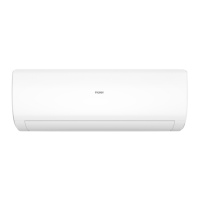
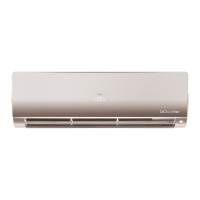

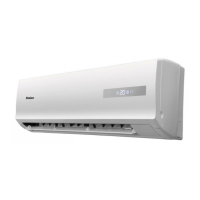
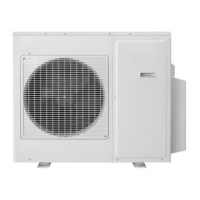
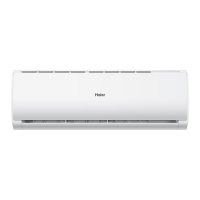
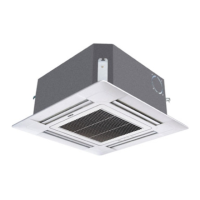




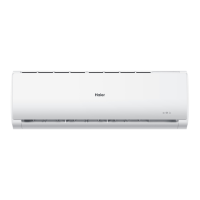
